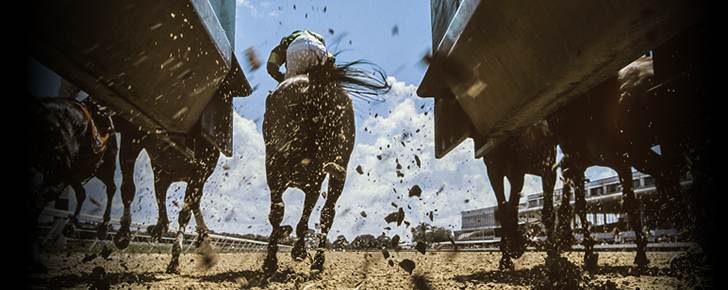
VIDEO LIBRARY
Free Horse Race Handicapping
Video Library
Knowledge Is Power



Videos are currently under development.
So in the meantime, here is something for you to chew on …
Statistical arbitrage, also known as stat arb, is a type of trading strategy that involves using mathematical models and statistical techniques to identify and exploit inefficiencies in financial markets. The goal of stat arb is to profit from discrepancies in the prices of two or more financial assets, such as stocks, currencies, or other securities.
In practice, stat arb traders use a variety of methods to identify mispricings in the market, such as analyzing historical price data, studying economic indicators, or using machine learning algorithms to identify patterns. Once a mispricing is identified, the trader takes advantage of it by buying the undervalued security and short selling the overvalued security. The goal is to profit from the difference in price between the two securities as they converge to their true values.
Statistical arbitrage strategies are often used in high-frequency trading, where traders use computer algorithms to identify and execute trades in milliseconds. This requires a significant amount of computational power and data analysis. In addition, this type of trading strategy requires a large amount of capital and a high degree of risk management, as small price movements can quickly erode profits.
Statistical Arbitrage has become a popular strategy among hedge funds and other institutional investors, where large amounts of capital and high-frequency trading expertise can be leveraged to generate substantial returns.
The potential for using statistical arbitrage (stat arb) in horse racing is based on the idea that, like any other market, horse racing bettors are not always efficient and there can be mispricings in the odds of different horses. By using statistical models and techniques, bettors can potentially identify these mispricings and profit from them by betting on the undervalued horse and against the overvalued horse.
There are several factors that can affect the odds and prices of horse racing, such as the horse’s performance history, the jockey, the trainer, and the track conditions. By analyzing only the useful data, bettors can build models that predict the true probability of a horse winning the given race and compare it to the current odds as displayed on the tote board. If there is a discrepancy, it may indicate an opportunity to apply stat arb.
In addition, horse racing is a sport with a lot of information and data, including historical performance data, which is critically valuable for building statistical models. This information can be used to create predictive models that can identify statistically significant factors and the weight of each factor to be used in calculating a horse’s chance of winning the given race, which can be useful in identifying mispricings. Once the mispricings are identified a bettor can determine whether to place a bet knowing the opportunity for profit.
However, it is important to note that using stat arb in horse racing can be challenging and there are some potential limitations. There is a lot of uncertainty in horse racing, which can make it difficult to predict the outcome of a race. In addition, there can be a lot of volatility in horse racing odds, which can make it difficult to execute bets at the right odds. Despite these challenges, the use of stat arb in horse racing has the potential to generate significant profits for bettors who are able to successfully identify and exploit inefficiencies in the betting market.
The horse racing industry is a multi-billion dollar industry that includes both thoroughbred and standardbred racing. Thoroughbred racing is the most popular and well-known form of horse racing, where horses race at a variety of distances on tracks such as dirt, turf, and synthetic surfaces. Standardbred racing, also known as harness racing, is where horses race at a specific distance, usually a mile, while pulling a two- wheeled cart called a sulky.
The horse racing industry is made up of several different components, including race tracks, horse owners and trainers, jockeys, and racing fans. Horse owners and trainers are responsible for training and caring for the horses, while jockeys are responsible for riding the horses in races. Racing fans place bets on the outcome of races, which generates revenue for the industry.
The market structure of horse racing is made up of various betting pools, where bets are placed on the outcome of races. The most common types of bets are win, place, and show bets, where bettors select a horse to win, place (finish first or second), or show (finish first, second or third) the race. In addition, there are also exotic bets such as exacta, trifecta and superfecta, where bettors select the horses that will finish in a specific order.
The horse racing industry is also regulated by government bodies, such as the Jockey Club, which is responsible for maintaining the integrity of the sport and enforcing rules and regulations. In addition, many countries have their own regulatory bodies that oversee horse racing. Horse racing is also heavily taxed, with a significant portion of the revenue generated by the industry going to the government.
Overall, the horse racing industry is a complex and dynamic market, with many different players and factors that can affect the outcome of races and the odds for each horse. This creates immense opportunity for intelligent bettors.
There are several factors that can affect horse racing odds and prices, including:
- Horse’s performance history: The past performance of a horse is one of the most important factors that can affect its odds. Horses with a history of winning races or performing well in previous races are likely to have much lower odds than horses with a less impressive track record.
- Jockey and trainer: The jockey and trainer of a horse can also affect its odds. Jockeys with a history of winning races and trainers with a reputation for developing successful horses are likely to have horses with reduced odds.
- Track conditions: Track conditions, such as the surface, weather, and distance of the race, can also affect a horse's odds. Horses that perform well on certain types of tracks or in specific weather conditions may have better odds than horses that do not.
- Current form: A horse’s current form is also a factor that can affect its odds. Horses that have performed well in recent races are likely to have lower odds than horses that have not.
- Betting market: The betting market also plays a role in determining horse racing odds. The amount of money bet on a horse determines its odds, with horses that are heavily bet become the favorites.
- Field size: the number of horses competing in the race can also affect the odds, as a bigger field size increase the chances of an unexpected outcome.
All these factors are used by the betting public to set the odds for each horse in a race. However, it is important to note that horse racing is a sport with a lot of uncertainty, and even the best-informed predictions can be affected by unexpected events, such as injuries or unforeseen track conditions. Therefore, it is important to be aware of all these factors and how they might affect the outcome of a race when placing bets. The key to profit is to locate mistakes made by the betting public.
There are several methodologies that traders can use to identify mispricings in horse racing odds:
- Statistical modeling: Mathematicians can use statistical models to analyze historical data on horse racing performance, track conditions, and numerous other factors that can affect a horse’s probability of winning. By building models that predict the horse’s chance of winning the race, bettors can compare these predictions to the current odds and identify any discrepancies. Bettors are looking for overlays.
- Machine Learning: Traders can also use machine learning algorithms to identify patterns in horse racing data and predict a horse’s chances of winning the given race. These algorithms can take into account a huge range of factors, including historical performance data, track conditions, and other relevant information.
- Odds Comparison: Bettors simply compare a horse’s predicted chance to win the race to odds on the tote board to identify discrepancies. The bettors job is to identify horses that are undervalued by the betting public, and take advantage of the discrepancy.
- Expert Opinion: The betting public also consults expert opinions and analysis from horse racing analysts, handicappers, and tipsters. Expert opinions are generally subjective, but the betting public believes they can provide valuable insight into the form and condition of horses, and the likelihood of a horse winning a race.
- Fundamentals: The betting public can also use fundamental analysis to identify what they think are mispricings in horse racing odds, by studying the financials of the horses, their trainers, jockeys and owners. However, the betting public can not come close to the accuracy and efficiency of properly built algorithms.
It is important to note that no single methodology can guarantee success in identifying mispricings in horse racing odds. Bettors should use the most reliable and sophisticated of methodologies and continuously monitor the market to identify potential opportunities. In addition, given the uncertainty and volatility of horse racing, even the best-informed predictions can be affected by unexpected events, such as injuries or unforeseen track conditions, so risk management is key.
There are several examples of statistical arbitrage (stat arb) strategies in horse racing:
- Betting on favorites: One stat arb strategy is to bet on the favorite horse in a race. Favorites have the lowest odds, but they also have the highest probability of winning. By betting on the favorite horse, bettors can generate a lot of winning tickets over time. The problem is the payouts are so low that it is virtually impossible for the bettor to make a profit long term.
- Arbitrage betting: Another stat arb strategy is to place bets on multiple horses in a race and take advantage of discrepancies in odds as the odds change closer to post time. Horses that are undervalued 15 minutes to post time may become overvalued as post time approaches. This particular approach requires extreme diligence on the part of the bettor.
- Machine learning: Using machine learning algorithms to predict a horse’s chance of winning race based on historical data and other factors, such as horse’s performance, track conditions, jockey and trainer, and current form can be very reliable when created correctly. This helps bettors identify mispricings in odds and make more informed decisions when placing bets.
- Betting the field: One stat arb strategy is to bet the field, which means betting on multiple horses in a race, usually those that have similar odds. By betting the field, bettors can profit from any discrepancies in odds between the horses and reduce their risk by spreading their bets across multiple horses.
- Back-to-lay: Bettors can also use a strategy called back-to-lay, which involves betting on a horse to win (backing) and then laying (betting against) the same horse at a lower price before the race starts. This strategy can be successful if the bettor has a very accurate knowledge of the horse’s odds and the odds significantly decrease before the race starts. Of course, this type of bet has to be offered where the bettor plays.
It is important to note that these strategies are not without risk, and traders should be aware of the volatility and uncertainty of horse racing, and use appropriate risk management techniques.
Statistical arbitrage, or "stat arb", is a method of using statistical analysis to identify profitable betting opportunities in horse racing. However, there are several potential challenges and limitations to using this approach.
One limitation is the availability of historical data. Horse racing is a sport with a long history, but not all races are well-documented, and the quality of data can vary widely. This can make it difficult to accurately analyze past performance and identify profitable betting opportunities. The good news is Winnermetrics did all of the hard work for you.
Another challenge is the complexity of horse racing. Unlike other sports, horse racing involves many, many variables, such as the skill of the jockey, the condition of the track, and the performance of individual horses to name only a few. This can make it very difficult to accurately predict the outcome of a race and identify profitable betting opportunities. The good news is Winnermetrics successfully accepted the challenge for you.
There is also the challenge of the market efficiency. Horse racing betting markets are not as efficient as other markets such as stock markets, due to a smaller pool of participants, lack of information, and a higher degree of emotion and irrationality among the betting public. This can make it harder to find mispricings and make profitable bets.
Additionally, Stat Arb can be a computationally expensive task, requiring a large amount of data and processing power, which can be a limitation for almost every individuals or organizations. The good news is Winnermetrics already did the hard work for you so you don’t need to worry about it..
Overall, while stat arb can be a powerful tool for identifying profitable betting opportunities in horse racing, it is not without its challenges and limitations. It requires a significant amount of self control, expertise, and resources to be successful.
Statistical arbitrage (stat arb) is a form of quantitative trading that uses mathematical models to identify and exploit inefficiencies in financial markets. In contrast, traditional horse racing betting methods rely on factors such as a horse's performance history, trainer, and jockey to make predictions about a horse’s chance of winning a given race.
Stat arb has the potential to generate much higher returns than traditional horse racing betting methods, as it uses a data-driven approach to identify and capitalize on market inefficiencies created by the less informed betting public. However, it also comes with some risk, as the models used in stat arb are based on historical data and may not perform as well when unexpected racing events happen.
Additionally, normal horse racing betting methods tend to be more accessible to the general public, while stat arb is typically only available by bettors with access to sophisticated technology and good management skills.
In summary, while traditional horse racing betting methods may be more accessible and easier to understand, stat arb offers the potential for much higher returns through a data-driven approach. But it also comes with increased risk, and it is typically only available to the most sophisticated bettors until now. Winnermetrics provides the results of the data-driven approach in easy to understand ratings.
Statistical arbitrage, or stat arb, has the potential to bring several benefits to the horse racing industry. Some of these benefits include:
- Improved predictions: By using mathematical models to analyze data such as a horse’s performance history, stat arb can help to identify statistically reliable factors and make more accurate predictions about the horse’s chance of winning a given race.
- Increased efficiency: Stat arb can help to identify and exploit inefficiencies in the horse racing market created by the betting public, leading to increased efficiency and potentially higher returns.
- Reduced emotional bias: Traditional horse racing betting methods often rely on factors such as a horse’s performance history, trainer, and jockey to make predictions. These methods can be influenced by emotional bias, which can lead to less accurate predictions. Stat arb, on the other hand, relies on data-driven models that are less susceptible to emotional bias.
- Reduced emotional bias: Traditional horse racing betting methods often rely on factors such as a horse’s performance history, trainer, and jockey to make predictions. These methods can be influenced by emotional bias, which can lead to less accurate predictions. Stat arb, on the other hand, relies on data-driven models that are less susceptible to emotional bias.
It is worth noting that using stat arb in horse racing is not a common practice yet, but Winnermetrics is working with early adopters. Stat arb requires sophisticated technology and large amounts of self-control, which can be a barrier for many individuals. Winnermetrics takes care of the data. You have to help with the self-control.

